Is cannabis a dangerous drug, or is it just a medical plant? Science cuts through the political rhetoric and can provide us with empirical answers. David Mizzi from THINK gets in touch with a number of scientific experts to look past the smoke and better understand cannabis.
On 14th December 2021, Malta legalised the cultivation and personal use of cannabis. While some hailed this landmark legislation as long overdue, others felt it would do more harm than good. But, are these fears well-founded, or are they the result of uninformed opinions? What’s the evidence out there? We asked these questions and others to Prof. Giuseppe Di Giovanni (Faculty of Medicine and Surgery, University of Malta [UM]) and some of his international collaborators working on the therapeutic benefits of cannabis. ‘First of all, I believe that marijuana and research on cannabinoids will give rise to the discovery of new potential treatments for many disorders, especially epilepsy, pain, and cancer,’ clarified Di Giovanni. ‘This idea is also shared by many neuroscientists, including Dr Mechoulam, who discovered THC in the ’60s,’ continues Di Giovanni .
‘Regarding the legalisation of the recreational use of cannabis, science does not need to take a position. This is more a political issue and after, a personal choice,’ according to Di Giovanni. While science does not need to take a stand, it does give us the tools to make rational and well-informed decisions.
What is cannabis?
Weed, marijuana, ganja, devil’s lettuce, hashish — these are all different terms for cannabis, a plant which has been used medicinally and recreationally for centuries. However, just like alcohol is an umbrella term for different types of booze (beer, whiskey, wine), Prof. Mauro Maccarrone (University of L’ Aquila, Italy) points out that ‘cannabis is just one word for many different formulations, each with a potential benefit or threat for health.’
Di Giovanni explains how the consumption of cannabis produces a wide range of psychotropic (mental) effects such as mild euphoria, relaxation, time distortion, sensory alterations, and a generally pleasant feeling. When compared to other psychoactive substances (such as alcohol and nicotine), cannabis has a low toxicity. In fact, the doses needed to induce a fatal effect are well beyond that consumed by humans. It has been calculated that a delta 9-THC lethal dose in a 70 kg human would be approximately 4g. Such a dose could not be realistically achieved in a human following oral consumption, smoking, or vaporising the substance, as delta 9-THC has a large margin of safety.
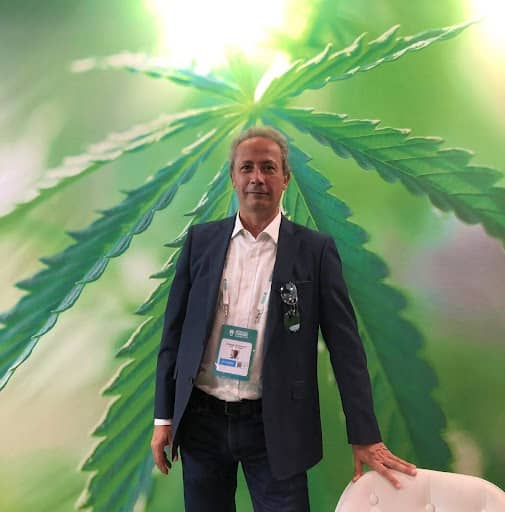
While many report pleasant experiences with cannabis, these are not universal. Some people report feeling anxious, fearful, or panicked. This can occur when a person smokes too much, the plant has a high potency, or if the person is inexperienced with the drug. Large doses can also result in acute psychosis such as hallucinations or delusions. While unpleasant, these temporary reactions are distinct from longer-lasting psychotic disorders, such as schizophrenia, which we will discuss later on.
This wide spectrum of effects occurs due to plant variability (each plant has different concentrations) and human variability (the way a person reacts). Di Giovanni explains how even if two people smoke from the same joint, there is no guarantee they will be affected the same way due to their unique genetic makeup.



Di Giovanni points out that ‘abusing cannabis, just like other drugs of addiction such as alcohol and nicotine, produce detrimental effects on brain function. Consequently, there is no scientific reason why legal drugs of abuse are sold by governments, while others are banned by society. This highlights a major paradox in international drug laws.’
How does it work? THC and CBD
All drugs have an active effect on the brain because they act similarly to chemical compounds that the body naturally produces . For example, heroin acts similarly to endorphins. Cannabinoids produce their effects by interacting with specific receptors that are part of the endocannabinoid system, located within different parts of the central nervous system and the body. Simply put, our brain and body produce endocannabinoids (similar to delta 9-THC) that regulate how cells communicate: how they send, receive, or process messages. The endocannabinoids regulate our brain and body functions as a conductor directs an orchestra, creating a beautiful symphony.
Cannabidiol (CBD) and tetrahydrocannabinol (THC) are the two main compounds found in cannabis. The psychotropic effects of cannabis are caused by THC, while CBD does not induce the ‘high’ and seems to have beneficial effects such as reducing anxiety and antipsychotic properties. It is believed that CBD has the ability to moderate the psychotropic effects of THC; this is known as the entourage effect. However, a 2020 study by Peter Cogan has cast doubt on this idea.
THC and CBD have a number of effects on the body’s systems. For example, THC works primarily on the brain’s CB1 receptors, while CBD acts on the CB2 receptors and several other targets. When it comes to the central nervous system, THC acts as a muscle relaxant and psychotropic (inducing a high) but can also cause short-term memory problems and distort the perception of time. CBD on the other hand, has anticonvulsant (prevents seizures) properties, as well as anxiolytic and antipsychotic properties.
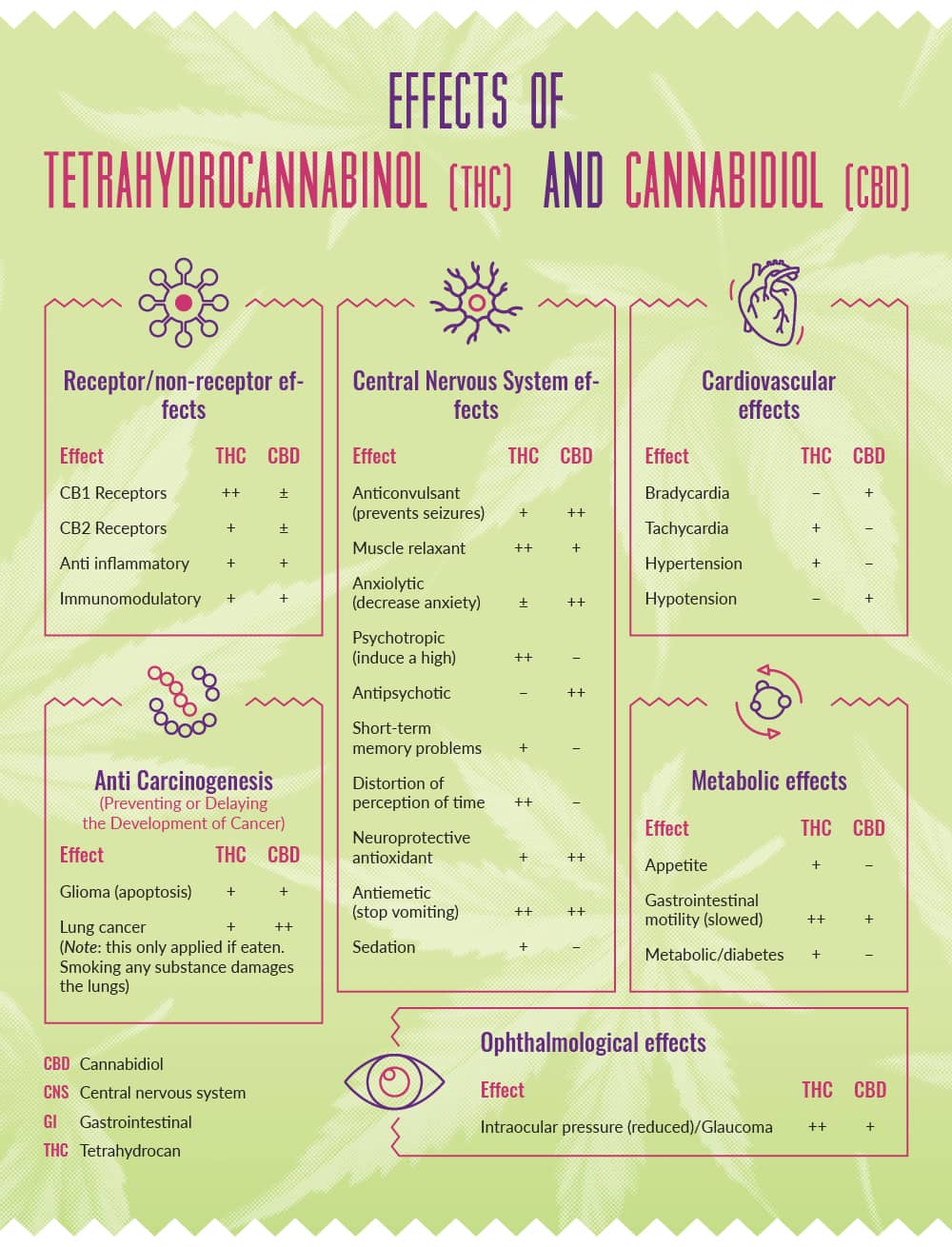
Is cannabis dangerous?
While cannabis’ dangers are significantly milder when compared to other substances, this does not mean it is harmless. For Prof. Patrizia Campolongo (Sapienza University, Rome, Italy), long term dangers include ‘addiction, altered brain development in adolescents, chronic bronchitis, as well as increased risk of chronic psychosis disorders (including schizophrenia) in persons with a predisposition to such disorders.’ Di Giovanni expounds on this point: ‘marijuana should definitely be forbidden to adolescents up to 21 year olds. The prefrontal cortex (think of it as the CEO of the body; it understands what is good, bad, and possible consequences), is the last part of the brain to mature.’ Consumption of cannabis during this stage can negatively affect a person.
One of the major issues with cannabis is its association with the development of schizophrenia. However, Prof. Matthew Hill (Calgary, Canada) is quick to point out that the nature of this association is still a debate within the academic community. While the risk of developing schizophrenia is terrifying, the bulk of human research conducted is observational, yielding correlations but not proving causation. This has left researchers debating whether cannabis can directly cause schizophrenia, or if it triggers schizophrenia in people already predisposed to developing the disorder. Di Giovanni advises, ‘adults with a family history of schizophrenia and other mental disorders should avoid cannabis or any other drug of abuse, including those that can be legally bought, such as cigarettes, caffeine, and alcohol,’ as these may also trigger certain conditions.
How will cannabis legislation impact society?
While science can give us a detailed explanation of what cannabis is, determining how legislation impacts society is a different matter. Taking a look across the Atlantic towards Canada, which legalised recreational marijuana in 2018, we can see how legislation impacted society there.
According to Hill, ‘based on my experience in Canada, legalisation literally had no discernible impact on society. There has been no change in things like fatal motor vehicle accidents; cannabis use by teenagers has not changed at all since legalisation; and in general, there has been no notable change in any aspect of society following legalisation.’
For Campolongo, while there is a consensus in the academic community of the strong therapeutic potential of cannabis, when it comes to recreational use, the issue is less clear cut. For one thing, ‘recreational cannabis would be subjected to totally different production methods, with different (not controlled or known) percentages of the various psychoactive and non-psychoactive substances.’
This sentiment is echoed by Maccarrone, given that there are hundreds of cannabinoids, ‘it is not yet clear how different combinations interact with each other and how they can impact on human health. Different formulations can have very different effects (from highly beneficial to highly dangerous) on human health and disease.’
Looking beyond the chemical composition, Hill believes that the majority of academics in North America view the prohibition model as being detrimental, particularly on marginalised and racialised populations. For example, ‘despite comparable levels of cannabis use between black and indigenous populations, and white populations, the former were up to five times more likely to be arrested and charged.’
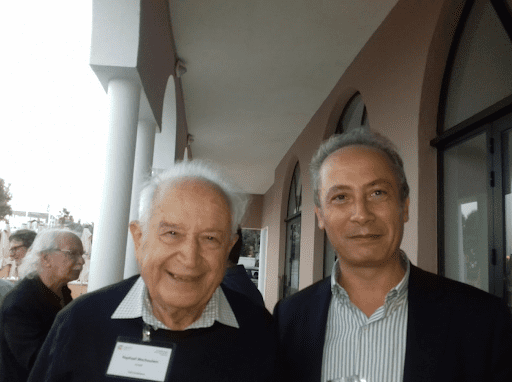
Prof. Raphael Mechoulam (Hebrew University of Jerusalem, Israel), arguably the father of cannabis research, is best known for his discovery of THC and endocannabinoids . He believes that if a country decides to legalise recreational cannabis, there should be a few safeguards. These include, ‘an age limit of over 21, the percent of THC in cannabis should be limited, similarly to alcohol — driving should be prohibited until a number of hours have passed, and hospitals should have staff that are experienced with cannabis medical problems.’
While cannabis is arguably less dangerous than other drugs of abuse and has an extremely bright future for therapeutic applications, it is not a miracle drug. It certainly does not deserve the stigma associated with it, and people who use it should not automatically be considered criminals. But, as with any drug on the legal market, including nicotine and alcohol, consumers need to know about the potential side effects. Cannabis is not the root of all evil, nor is it the cure for all diseases. ‘More research on cannabinoids is warranted. Once we understand the mechanisms by which cannabis affects the body, its benefits can reach more patients and also consumers,’ Di Giovanni concluded.
More information about current preclinical and clinical research on cannabinoids, collaborations, and student opportunities can be directed to Prof. Giuseppe Di Giovanni.
Further Reading
Cogan, P. (2020) The ‘entourage effect’ or ‘hodge-podge hashish’: the questionable rebranding, marketing, and expectations of cannabis polypharmacy. Expert Review Of Clinical Pharmacology, 13(8), 835-845. https://doi.org/10.1080/17512433.2020.1721281
Di Giovanni, G., & Agius, A. (2017). Is cannabis the best medicine for chronic pain? – Think Magazine. Think Magazine. Retrieved 10 January 2022, from https://www.um.edu.mt/think/is-cannabis-the-best-medicine-for-chronic-pain/.
Di Giovanni, G. Cannabis Medicine Offers Hope for Severe Paediatric Epilepsies. XJENZA ONLINE Vol 6 (2), 62-64. https://www.xjenza.org/JOURNAL/OLD/6-1-2018/06.pdf
Di Giovanni, G. (2016). Marijuana for Epilepsy – Think Magazine. Think Magazine. Retrieved 10 January 2022, from https://www.um.edu.mt/think/marijuana-for-epilepsy/.
Grillo, A., …, Di Giovanni, G. (2021) Selective Fatty Acid Amide Hydrolase Inhibitors as Potential Novel Antiepileptic Agents. ACS Chemical Neuroscience 12 (9), 1716-1736.
Colangeli, R., Teskey, G.C., Di Giovanni, G. (2021) Endocannabinoid-serotonin systems interaction in health and disease. Progress in Brain Research 259, 83-134
Di Maio, R., Colangeli, R., Di Giovanni, G., 2019. WIN55, 212-2 Reverted Pilocarpine-Induced Status Epilepticus Early Changes of the interaction among 5-HT2C/NMDA/CB1 Receptors in the Rat Hippocampus. ACS Chemical Neuroscience.
Colangeli, R., …, Di Giovanni, G. (2019) Synergistic action of CB1 and 5-HT2B receptors in preventing pilocarpine-induced status epilepticus in rats. Neurobiology of Disease 125:135-145.
Colangeli, R., …, Di Giovanni, G. (2017) The FAAH inhibitor URB597 suppresses hippocampal maximal dentate afterdischarges and restores seizure-induced impairment of short and long-term synaptic plasticity. Scientific Reports, 7 (1), 11152.
D’Souza, D., …, Krystal, J.H. (2004). The Psychotomimetic Effects of Intravenous Delta-9-Tetrahydrocannabinol in Healthy Individuals: Implications for Psychosis. Neuropsychopharmacology, 29(8), 1558-1572. https://doi.org/10.1038/sj.npp.1300496
Sachs, J., McGlade, E., Yurgelun-Todd, D. (2015). Safety and Toxicology of Cannabinoids. Neurotherapeutics, 12(4), 735-746. https://doi.org/10.1007/s13311-015-0380-8
Zuardi, Mechoulam, R. (1995). Antipsychotic effect of cannabidiol. The Journal of clinical psychiatry, 56(10), 485–486.

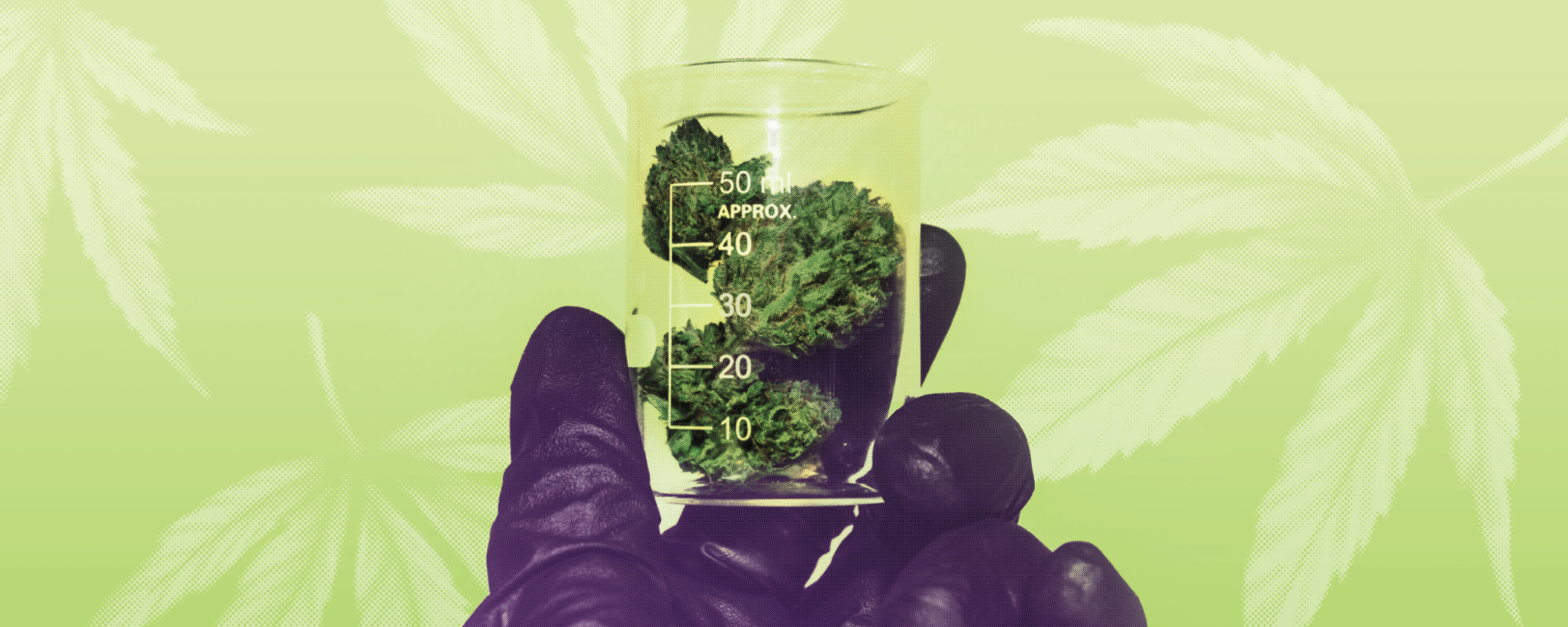
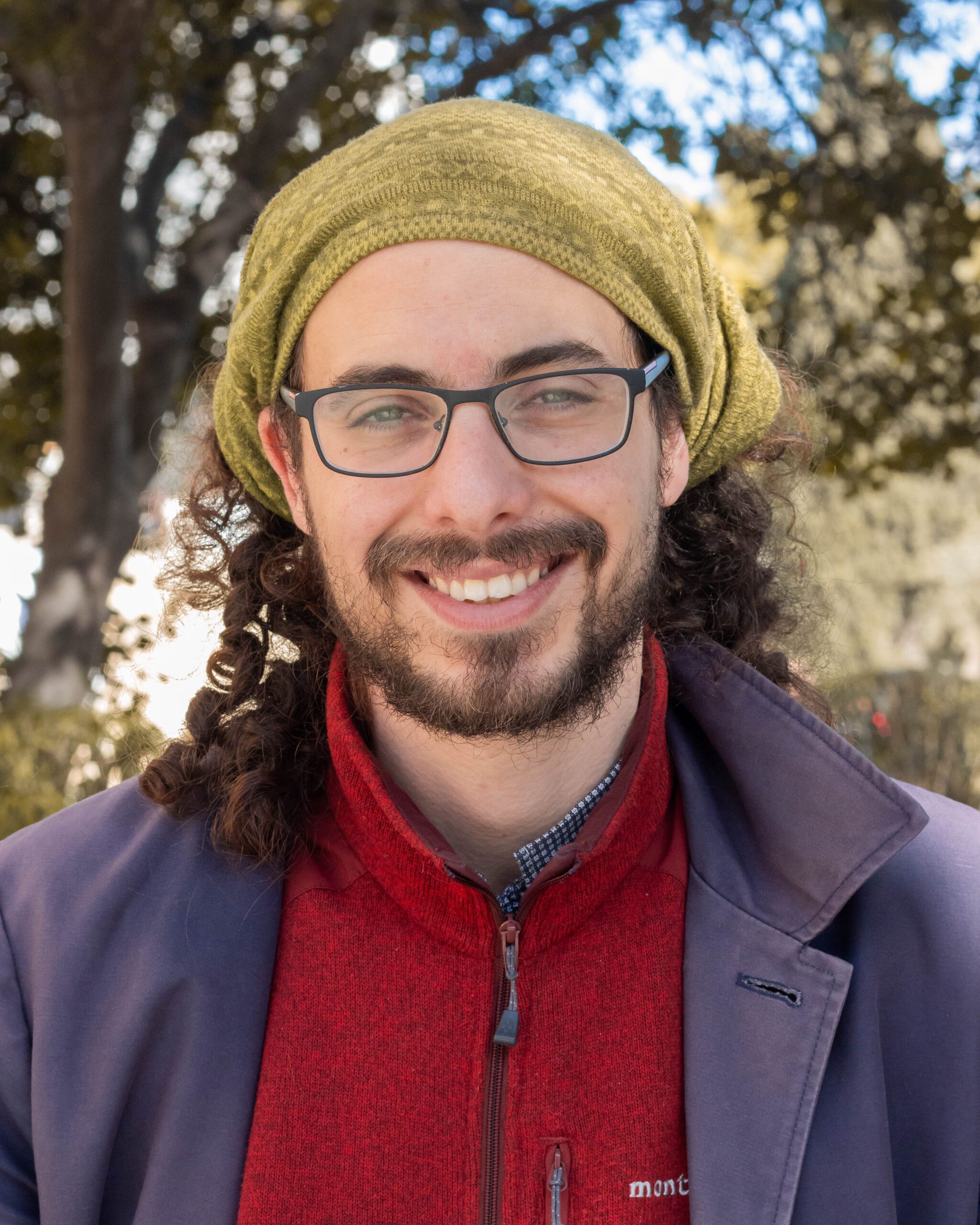



Comments are closed for this article!